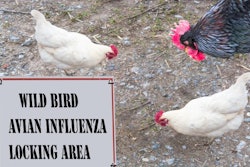
Highly pathogenic avian influenza (HPAI) has returned to the poultry industry in Bhutan after an absence of eight months, and new cases have been confirmed in Bulgaria, Iran, Nepal, and Taiwan.
During the second week of April, the H5N1 variant of the HPAI virus was detected in the Chukha district of the central Asian state of Bhutan.
In the official report of the agriculture ministry to the World Organisation for Animal Health (OIE), the 2,000 affected birds are described as belonging to a “backyard” flock on the outskirts of Phuentsholing, a town close to the border with India. More than 260 birds died, and 1,095 were culled to prevent further spread of the disease. A nearby flock of similar size was also scheduled for destruction.
In a more recent report, Kuensel Online puts the number of farms affected by the disease in Bhutan at 14, including one with turkeys. A total of 1,130 head of poultry had been culled by the time of this report, and the authorities had destroyed 4,000 eggs, more than 600 kg feed, and 12 chicken coops.
Taiwan’s Council of Agriculture has confirmed to the OIE a further two outbreaks of HPAI linked to the H5N2 virus subtype. Both occurred around the start of this month, and involved a farm with 11,270 native chickens at Dongshi in the county of Yunlin, and among a group of 11 birds of the same type at a slaughterhouse in the Wanhua district of Taipei city. Outbreaks reported the previous week were in the same locations.
The Iran Veterinary Organization has informed the OIE about two new outbreaks of HPAI linked to the H5N8 virus variant. The virus has caused disease outbreaks in the country since the end of 2018 up until the end of February. Latest to be affected by the disease last week were 10,000 village poultry in the capital, Tehran, and a flock of 65,000 laying poultry in the north-western area, East Azerbayejan. Almost 4,300 of the birds died, and the rest have been destroyed.
The agriculture authority in Kuwait has declared the country free of HPAI to the OIE. There have been no cases of the disease since the H5N8 virus was detected at a live bird market in Al Farwaniyah governorate in the first week of February.
Ninth outbreak in Nepal
Nepal’s total number of HPAI outbreaks in the latest disease wave has risen to nine. New cases linked to the H5N1 virus variant were detected at a farm with around 1,000 laying hens in the Lalitput district of Bagmati zone, according to the official report from the agriculture ministry to the OIE. Direct losses of poultry through mortality and destruction in these outbreaks have almost reached 100,000.
The country’s Livestock Department has sent samples of dead birds to Australia for genome sequencing, reports Nepali Sansar. The agency says it is looking for confirmation of the disease, and clues to any genetic changes in the virus.
Qatar halts poultry imports from India
Following a new outbreak of HPAI in the state of Orissa (Odisha) reported last week, the Qatar National Health Authority has banned all imports of poultry meat and egg products from India, reports The Daily Pioneer.
Europe: New HPAI outbreaks in Bulgaria
There have been three new outbreaks of HPAI caused by the H5N8 virus variant, according to the latest official report from the country’s agriculture ministry to the OIE.
All three were in the province of Plovdiv in central Bulgaria. Affected were a backyard flock as well as two farms in Asenovgrad, in which around 300 birds died of the disease in each case. Over 203,000 head of poultry were culled as the result of these latest outbreaks.
Based on official reports, the new cases are more closely connected to a series of outbreaks in the southeast of the country that stopped in December of 2018 than to two outbreaks in ducks linked to an unidentified H5 virus subtype in central Bulgaria at the start of this month.
Denmark lifts last of avian flu controls
Restrictions put in place after an H7 low-pathogenic avian influenza (LPAI) virus was found in a flock of ducks reared for sport at Brenderup on Funen have been lifted, according to the Danish Veterinary and Food Administration.
Similar restrictions were lifted at the end of March around Terndrup, where an H5 LPAI virus had previously been detected in an organic layer flock.
















